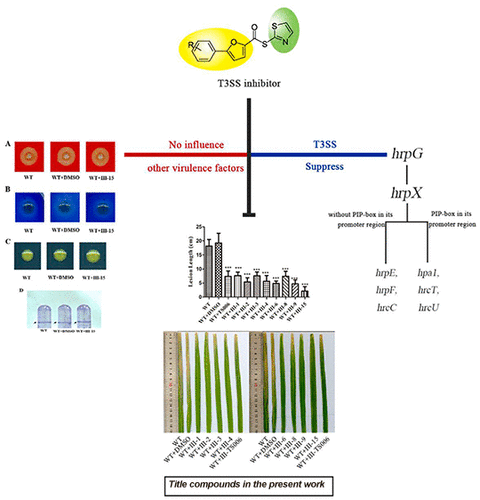当前位置:
X-MOL 学术
›
J. Agric. Food Chem.
›
论文详情
Our official English website, www.x-mol.net, welcomes your
feedback! (Note: you will need to create a separate account there.)
Novel S-Thiazol-2-yl-furan-2-carbothioate Derivatives as Potential T3SS Inhibitors Against Xanthomonas oryzae on Rice.
Journal of Agricultural and Food Chemistry ( IF 5.7 ) Pub Date : 2019-10-15 , DOI: 10.1021/acs.jafc.9b04085 Shan Jiang 1 , Min He 1 , Xu-Wen Xiang 1 , Muhammad Adnan 1 , Zi-Ning Cui 1
Journal of Agricultural and Food Chemistry ( IF 5.7 ) Pub Date : 2019-10-15 , DOI: 10.1021/acs.jafc.9b04085 Shan Jiang 1 , Min He 1 , Xu-Wen Xiang 1 , Muhammad Adnan 1 , Zi-Ning Cui 1
Affiliation

|
Bacterial leaf blight (BLB) caused by Xanthomonas oryzae pv oryzae (Xoo) is considered as the most destructive disease of rice. The use of bactericides is among the most widely used traditional methods to control this destructive disease. The excessive and repeated use of the same bactericides is also becoming the reason behind the development of bactericide resistance. The widely used method for finding the new antimicrobial agents often involves the bacterial virulence factors as a target without affecting bacterial growth. Type III secretion system (T3SS) is a protein appendage and is considered as having essential virulence factors in most Gram-negative bacteria. Due to the conserved construct, T3SS has been regarded as an important mark for the blooming of novel antimicrobial drugs. Toward the search of new T3SS inhibitors, an alternative series of 1,3-thiazole derivatives were designed and synthesized. Their structures were characterized and confirmed by 1H NMR, 13C NMR, MS, and elemental analysis. All the title compounds inhibited the promoter activity of hpa1 gene significantly. Eight of them showed better inhibition than our previous T3SS inhibitor TS006 (o-coumaric acid, OCA). The treatment of Xoo with eight compounds significantly attenuated HR without affecting bacterial growth. The mRNA levels of some representative genes (hrp/hrc genes) were reduced up to different extents. In vivo bioassay results showed that eight T3SS inhibitors could reduce bacterial leaf blight and bacterial leaf streak symptoms on rice, significantly.
中文翻译:

新型S-噻唑-2-基-呋喃-2-碳硫盐衍生物作为水稻抗稻草单胞菌的潜在T3SS抑制剂。
水稻黄单胞菌(Xanthomonas oryzae)造成的细菌性叶枯病(BLB)被认为是水稻最具破坏性的疾病。杀菌剂的使用是控制这种破坏性疾病的最广泛使用的传统方法之一。过度使用和重复使用相同的杀菌剂也成为产生抗药性的原因。寻找新的抗微生物剂的广泛使用的方法通常将细菌毒力因子作为目标,而不影响细菌的生长。III型分泌系统(T3SS)是一种蛋白质附件,在大多数革兰氏阴性细菌中被认为具有必需的毒力因子。由于保守的构建,T3SS被认为是新的抗菌药物泛滥的重要标志。为了寻找新的T3SS抑制剂,设计和合成了另一系列的1,3-噻唑衍生物。通过1 H NMR,13 C NMR,MS和元素分析对它们的结构进行了表征和确认。所有标题化合物均显着抑制hpa1基因的启动子活性。他们中的八个显示出比我们以前的T3SS抑制剂TS006(邻香豆酸,OCA)更好的抑制作用。用八种化合物处理Xoo可以显着降低HR,而不会影响细菌的生长。一些代表性基因(hrp / hrc基因)的mRNA水平降低了不同程度。体内生物测定结果表明,八种T3SS抑制剂可显着减轻水稻的细菌性叶枯病和细菌性叶纹症状。和元素分析。所有标题化合物均显着抑制hpa1基因的启动子活性。他们中的八个显示出比我们以前的T3SS抑制剂TS006(邻香豆酸,OCA)更好的抑制作用。用八种化合物处理Xoo可以显着降低HR,而不会影响细菌的生长。一些代表性基因(hrp / hrc基因)的mRNA水平降低了不同程度。体内生物测定结果表明,八种T3SS抑制剂可显着减轻水稻的细菌性叶枯病和细菌性叶纹症状。和元素分析。所有标题化合物均显着抑制hpa1基因的启动子活性。他们中的八个显示出比我们以前的T3SS抑制剂TS006(邻香豆酸,OCA)更好的抑制作用。用八种化合物处理Xoo可以显着降低HR,而不会影响细菌的生长。一些代表性基因(hrp / hrc基因)的mRNA水平降低了不同程度。体内生物测定结果表明,八种T3SS抑制剂可显着减轻水稻上的细菌性叶枯病和细菌性叶纹症状。用八种化合物处理Xoo可以显着降低HR,而不会影响细菌的生长。一些代表性基因(hrp / hrc基因)的mRNA水平降低了不同程度。体内生物测定结果表明,八种T3SS抑制剂可显着减轻水稻的细菌性叶枯病和细菌性叶纹症状。用八种化合物处理Xoo可以显着降低HR,而不会影响细菌的生长。一些代表性基因(hrp / hrc基因)的mRNA水平降低了不同程度。体内生物测定结果表明,八种T3SS抑制剂可显着减轻水稻的细菌性叶枯病和细菌性叶纹症状。
更新日期:2019-10-16
中文翻译:

新型S-噻唑-2-基-呋喃-2-碳硫盐衍生物作为水稻抗稻草单胞菌的潜在T3SS抑制剂。
水稻黄单胞菌(Xanthomonas oryzae)造成的细菌性叶枯病(BLB)被认为是水稻最具破坏性的疾病。杀菌剂的使用是控制这种破坏性疾病的最广泛使用的传统方法之一。过度使用和重复使用相同的杀菌剂也成为产生抗药性的原因。寻找新的抗微生物剂的广泛使用的方法通常将细菌毒力因子作为目标,而不影响细菌的生长。III型分泌系统(T3SS)是一种蛋白质附件,在大多数革兰氏阴性细菌中被认为具有必需的毒力因子。由于保守的构建,T3SS被认为是新的抗菌药物泛滥的重要标志。为了寻找新的T3SS抑制剂,设计和合成了另一系列的1,3-噻唑衍生物。通过1 H NMR,13 C NMR,MS和元素分析对它们的结构进行了表征和确认。所有标题化合物均显着抑制hpa1基因的启动子活性。他们中的八个显示出比我们以前的T3SS抑制剂TS006(邻香豆酸,OCA)更好的抑制作用。用八种化合物处理Xoo可以显着降低HR,而不会影响细菌的生长。一些代表性基因(hrp / hrc基因)的mRNA水平降低了不同程度。体内生物测定结果表明,八种T3SS抑制剂可显着减轻水稻的细菌性叶枯病和细菌性叶纹症状。和元素分析。所有标题化合物均显着抑制hpa1基因的启动子活性。他们中的八个显示出比我们以前的T3SS抑制剂TS006(邻香豆酸,OCA)更好的抑制作用。用八种化合物处理Xoo可以显着降低HR,而不会影响细菌的生长。一些代表性基因(hrp / hrc基因)的mRNA水平降低了不同程度。体内生物测定结果表明,八种T3SS抑制剂可显着减轻水稻的细菌性叶枯病和细菌性叶纹症状。和元素分析。所有标题化合物均显着抑制hpa1基因的启动子活性。他们中的八个显示出比我们以前的T3SS抑制剂TS006(邻香豆酸,OCA)更好的抑制作用。用八种化合物处理Xoo可以显着降低HR,而不会影响细菌的生长。一些代表性基因(hrp / hrc基因)的mRNA水平降低了不同程度。体内生物测定结果表明,八种T3SS抑制剂可显着减轻水稻上的细菌性叶枯病和细菌性叶纹症状。用八种化合物处理Xoo可以显着降低HR,而不会影响细菌的生长。一些代表性基因(hrp / hrc基因)的mRNA水平降低了不同程度。体内生物测定结果表明,八种T3SS抑制剂可显着减轻水稻的细菌性叶枯病和细菌性叶纹症状。用八种化合物处理Xoo可以显着降低HR,而不会影响细菌的生长。一些代表性基因(hrp / hrc基因)的mRNA水平降低了不同程度。体内生物测定结果表明,八种T3SS抑制剂可显着减轻水稻的细菌性叶枯病和细菌性叶纹症状。






























 京公网安备 11010802027423号
京公网安备 11010802027423号